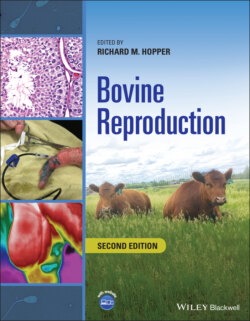Читать книгу Bovine Reproduction - Группа авторов - Страница 257
Corkscrew Claw
ОглавлениеCorkscrew claw (CSC) is observed in the young adult beef animal and usually involves the lateral claw of both hindlimbs. In some breeds, such as Brahman and Brahman crosses, it can occur on the medial claw of both forelimbs. Because CSC can be seen in calves and yearlings, some practitioners believe that this is a heritable condition. However, it appears that this is a management‐induced problem, in our opinion, even in younger animals. Offering overabundant feed can lead to rapid skeletal growth and subsequent epiphysitis and rotational limb deformity. This results in abnormal load bearing and compensatory changes in the hoof. Therefore rapidly growing animals may express CSC. To prevent structural changes to the phalanges secondary to CSC, corrective hoof trimming must occur during the active growth phase. In the fully grown adult, CSC cannot be cured, only managed [8] (Figure 16.16).
Figure 16.16 Corkscrew claw on the lateral claw of a Brahman bull.
It is unknown whether bone remodeling in the distal phalanx is the cause or effect of CSC. In some patients with CSC, the second and third phalanges become misaligned and the third phalanx becomes narrower with an abaxial curvature. This leads to abnormal load bearing, which affects the white line and leads to separation. In other patients with CSC, the growth rate of the middle to caudal portion of the wall is faster than the fore portion of the toe, which causes the animal to bear weight on the abaxial wall, predisposing to bruising, abscessation, and sole ulcers.
Correction of CSC involves balancing the weight‐bearing surface of both claws. It is best to trim excess from the medial claw just until the white line is apparent. Next shorten the affected claw to the same length as the normal claw. Remove the upward deviation and rotation of the wall with a grinder or nippers. The heel is often higher in the CSC and it should not be lowered. Bevel the sole to encourage wall contact with the sole surface. At this point, there may not be very much area for bearing weight, but it will encourage more favorable wear for the hoof wall. Corrective hoof trimming should occur every four to six months.
